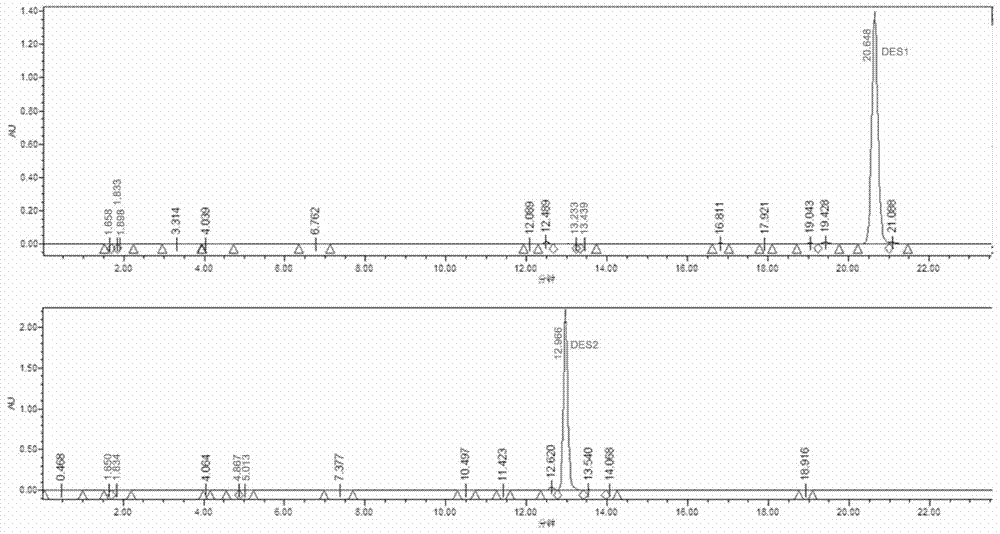Application of nano-liposome technology in bioconversion
A nanoliposome and biotransformation technology, applied in the direction of adding compounds to stimulate growth, etc., can solve the problems of bacterial growth and transformation inhibition, transformation rate decline, etc., to improve water solubility, good biocompatibility, improve Effect of Feed Concentration and Conversion
- Summary
- Abstract
- Description
- Claims
- Application Information
AI Technical Summary
Problems solved by technology
Method used
Image
Examples
Embodiment 1
[0052] Example 1: The 11α hydroxylation reaction of Metarhizium anisopliae 11490 on L-ethyl sterenedione nanoliposomes, with a feed concentration of 2 g / L.
[0053] (1) Preparation of substrate nanoliposomes
[0054] Using lecithin as a carrier, the substrate L-ethyl sterenedione was made into nano liposomes with an average particle size of 131.6 nm.
[0055] (2) Microbial transformation
[0056] Microbial strain: Metarhizium anisopliae 11490, strain deposit number CCTCC M2011240, this strain can introduce 11α hydroxyl on L-ethyl sterenedione.
[0057] (3) Medium
[0058] Slant culture: Potato dextrose agar (PDA) medium, which contains 0.25% of silkworm pupa powder;
[0059] Fermentation medium: 10g / L glucose, 10g / L soybean powder, 5g / L silkworm pupa powder, pH 6.5;
[0060] (4) Microbial culture
[0061] Strains were cultured for 24 hours under the conditions of 220r / min and 40mL / 250mL shake flask on a rotary shaker at 28°C to obtain seed liquid;
[0062] (5) Biotransformation
[0063] Put t...
Embodiment 2
[0065] Example 2: The 11α hydroxylation reaction of Metarhizium anisopliae 11490 on L-ethyl sterenedione nanoliposomes, with a feeding concentration of 4 g / L.
[0066] (1) Preparation of substrate nanoliposomes
[0067] Using lecithin as a carrier, the substrate L-ethyl sterenedione was made into nano liposomes with an average particle size of 131.6 nm.
[0068] (2) Microbial transformation
[0069] Microbial strain: Metarhizium anisopliae 11490, strain deposit number CCTCC M2011240, this strain can introduce 11α hydroxyl on L-ethyl sterenedione.
[0070] (3) Medium
[0071] Slant culture: Potato dextrose agar (PDA) medium, which contains 0.25% of silkworm pupa powder;
[0072] Fermentation medium: 10g / L glucose, 10g / L soybean powder, 5g / L silkworm pupa powder, pH 6.5;
[0073] (4) Microbial culture
[0074] Strains were cultured for 24 hours under the conditions of 220r / min and 40mL / 250mL shake flask on a rotary shaker at 28°C to obtain seed liquid;
[0075] (5) Biotransformation
[0076] Pu...
Embodiment 3
[0078] Example 3: 11α hydroxylation reaction of Metarhizium anisopliae 11490 on L-ethyl sterenedione nanoliposomes, with a feed concentration of 6 g / L.
[0079] (1) Preparation of substrate nanoliposomes
[0080] Using lecithin as a carrier, the substrate L-ethyl sterenedione was made into nano liposomes with an average particle size of 131.6 nm.
[0081] (2) Microbial transformation
[0082] Microbial strain: Metarhizium anisopliae 11490, strain deposit number CCTCC M2011240, this strain can introduce 11α hydroxyl on L-ethyl sterenedione.
[0083] (3) Medium
[0084] Slant culture: Potato dextrose agar (PDA) medium, which contains 0.25% of silkworm pupa powder;
[0085] Fermentation medium: 10g / L glucose, 10g / L soybean powder, 5g / L silkworm pupa powder, pH 6.5;
[0086] (4) Microbial culture
[0087] Strains were cultured for 24 hours under the conditions of 220r / min and 40mL / 250mL shake flask on a rotary shaker at 28°C to obtain seed liquid;
[0088] (5) Biotransformation
[0089] Put the p...
PUM
| Property | Measurement | Unit |
|---|---|---|
| particle size | aaaaa | aaaaa |
| encapsulation rate | aaaaa | aaaaa |
Abstract
Description
Claims
Application Information
 Login to View More
Login to View More - Generate Ideas
- Intellectual Property
- Life Sciences
- Materials
- Tech Scout
- Unparalleled Data Quality
- Higher Quality Content
- 60% Fewer Hallucinations
Browse by: Latest US Patents, China's latest patents, Technical Efficacy Thesaurus, Application Domain, Technology Topic, Popular Technical Reports.
© 2025 PatSnap. All rights reserved.Legal|Privacy policy|Modern Slavery Act Transparency Statement|Sitemap|About US| Contact US: help@patsnap.com



